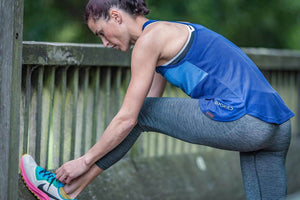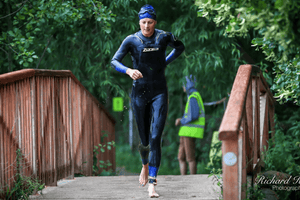The newest kid on the multi-sport block is the crazy sport of Swimrun. There are many elements to this event that make it stand out from the crowd. My name is Alex Hemsley, English National Aquathlon Champion, and it’s my job to introduce you to this unique sport and how to train for such an event.

What is swimrun?
You might be thinking, "well that’s obvious, it’s swimming and running". Well yes, but maybe not as you think. Swimrun is an endurance event with distances often equalling that of a marathon or more. But oh no, you won’t just be running those miles on a road! The swim and run are broken up into multiple small runs/swims of varying distances, alternating between the two sports. Often, swimming in multiple lakes or around a shoreline and running across fells, through rivers, and over mountains. Swimrun events take place in the most beautiful locations in both the UK and abroad and you just have to remember to appreciate it while you're racing!
Transitions
If you're a triathlete or multi-sport athlete, you will be familiar with transitioning from one discipline to another. In swimrun, there are no transitions: you swim in your running shoes and run in your wetsuit. Because of this, there is some specialist equipment you will want to invest in before your race.
Swimrun Equipment
Swimrun Wetsuit
A specific swimrun wetsuit is a must if you don’t want to get too hot on the run. There are plenty available online and more are becoming available in stores. My top tip is to make sure you follow the size guide if you don’t want horrific chafing from running in a wetsuit! Specialist Swimrun wetsuits have a built-in whistle which can be an essential item and clever pockets so you can carry gels.
Trail shoes
Due to the uneven terrains on the run, a good trail shoe is well worth investing in as you will also be running with wet feet from the start. It is crucial that your shoes are clean before a race due to the unique biodiversity of the areas you are racing in. So no trail shoes that have lingered in a cupboard for months since last winter!
Fuel/drink container
Swimrun events have pioneered plastic-free racing which, in these times of environmental decline, is so important. This means you need a container that you can use for water/electrolytes at the feed stations. My preference is a soft flask that can be folded up and put in a pocket on my swimrun suit. You can often buy them at events.
Hand paddles and pull buoys
Another aspect that makes swimrun unique is you can use whatever equipment you want... but before you think of taking your fins, everything you start the race with you have to finish the race with. So you need to be cunning with your swimming aids! Many people use paddles and pull buoys as swimming in shoes creates a lot of drag.
Pull buoys can either be altered to make some ties so you can attach it to the outside of your leg for the run or you can buy specific swimrun ones. With hand paddles, make sure you can quickly get them on and off otherwise you’ll be running with your goggles on as your hands won’t be free to take them off.
A partner
One final aspect of this is that swimrun is a team event and you can only compete in pairs. You can’t be more than 10 meters apart from each other at any one time. Some teams tether themselves together with a piece of rope cut to the specific length of 10m.

How do you train for swimrun?
You'll need to do lots of endurance swim sets both in the pool and outdoors. Make sure you follow your swim sets with a run as it feels very alien at first and feels different to running after cycling, which is the more traditional transition.
Get out on the trails and hit the hills in all weathers as it might not be a nice day when you are racing so don’t dodge the weather in training!
Train as much as you can with your partner as you need to know each other’s strengths and weaknesses and work out what works best for you as a team. Is one person going to lead on the swim and the other on the run? Or one person does one swim and run and the other does the next. You might not follow it on race day but it’s worth having a strategy. Training together also helps you know each other’s natural cadence in swim and run so you can try to match this.
Before the race, go and do a recce where you swim in your swimrun suit and running shoes and run in your suit and wet shoes. This will help you work out what might happen on race day. Here's a recce checklist:
- Do you want to wear socks or not?
- Do you want to undo your swimrun suit?
- Will you get blisters from running in wet shoes?
- Which gels do you want and how many?
- Will you run with your hat and goggles on and if not where will you put them?

How do swimrun races work?
Prior to race day, there will be a map and details of the number of swims/runs and their distance and elevation. Study these carefully as you want to know how many you’ve got on race day and when you’ve finished the hills it’s good to know this!
Registration and race briefing will either be the day of the event or the day before. Make sure you attend and pay attention as they will tell you what the markers look like as the whole course isn’t marked so you need to pay attention! They will often inspect your trainers, so make sure they are clean.
Lay all your kit out so you know you have what you need. You will be given number bibs and these must be on you and visible at all times.
On race day, make sure you eat a good breakfast no sooner than 2 hours before otherwise running in your tight suit will make you feel very sick!
The meeting point is often close to the finish of the race so it’s all aboard a coach to take you to the start, often driving along some of the route you will be running and swimming.
And then the fun begins – you swim and run your way back to the finish! There will be feed stations along the route; these are well stocked with everything you could need including new potatoes! But remember not to get carried away or stop for too long or you might seize up or get a stitch.
At the finish, bask in the glory of completing one of the toughest but most fun multi-sports around.
This is by far my favourite event as you get to swim and run in the most beautiful locations with one of your friends. What’s not to love?
About the author: Alex Hemsley is a Team GB Age Group athlete and National Aquathlon Champion.








































